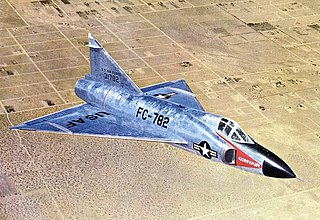
The Convair F-102 Delta Dagger was an interceptor aircraft designed and produced by the American aircraft manufacturer Convair. A member of the Century Series, the F-102 was the first operational supersonic interceptor and delta-wing fighter operated by the United States Air Force (USAF).
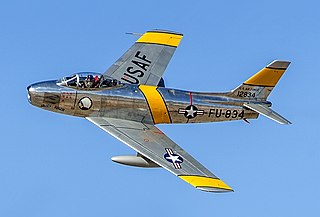
The North American F-86 Sabre, sometimes called the Sabrejet, is a transonic jet fighter aircraft. Produced by North American Aviation, the Sabre is best known as the United States' first swept-wing fighter that could counter the swept-wing Soviet MiG-15 in high-speed dogfights in the skies of the Korean War (1950–1953), fighting some of the earliest jet-to-jet battles in history. Considered one of the best and most important fighter aircraft in that war, the F-86 is also rated highly in comparison with fighters of other eras. Although it was developed in the late 1940s and was outdated by the end of the 1950s, the Sabre proved versatile and adaptable and continued as a front-line fighter in numerous air forces.

The Lockheed F-94 Starfire is a first-generation jet powered all-weather day/night interceptor aircraft designed and produced by Lockheed Corporation. It was the first operational United States Air Force (USAF) fighter equipped with an afterburner as well as being the first jet-powered all-weather fighter to enter combat during the Korean War.

The Northrop F-89 Scorpion is an all-weather, twin-engined interceptor aircraft designed and produced by the American aircraft manufacturer Northrop Corporation. It was the first jet-powered aircraft to be designed for the interceptor role from the outset to enter service, as well as the first combat aircraft to be armed with air-to-air nuclear weapons in the form of the unguided Genie rocket. The name Scorpion came from the aircraft's elevated tail unit and high-mounted horizontal stabilizer, which kept it clear of the engine exhaust.

The North American F-107 is North American Aviation's entry in a United States Air Force tactical fighter-bomber design competition of the 1950s, based on the F-100 Super Sabre. It incorporated many innovations and radical design features, notably the over-fuselage air intakes. The competition was eventually won by the Republic F-105 Thunderchief, and two of the three F-107 prototypes ended their lives as test aircraft. One is on display at the National Museum of the United States Air Force and a second at Pima Air and Space Museum.

The North American YF-93 was an American fighter development of the F-86 Sabre that emerged as a radically different variant that received its own designation. Two were built and flown before the project was eventually canceled.
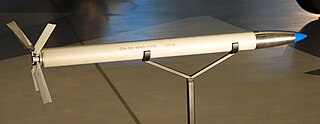
The Mk 4 Folding-Fin Aerial Rocket (FFAR), also known as "Mighty Mouse", is an unguided rocket used by United States military aircraft. It was 2.75 inches (70 mm) in diameter. Designed as an air-to-air weapon for interceptor aircraft to shoot down enemy bombers, it primarily saw service as an air-to-surface weapon. The FFAR has been developed into the modern Hydra 70 series, which is still in service.

The Canadair Sabre is a jet fighter aircraft built by Canadair under licence from North American Aviation. A variant of the North American F-86 Sabre, it was produced until 1958 and used primarily by the Royal Canadian Air Force (RCAF) until replaced with the Canadair CF-104 in 1962. Several other air forces also operated the aircraft.

The 138th Fighter Wing is a unit of the Oklahoma Air National Guard, stationed at the Tulsa Air National Guard Base at Tulsa International Airport in Tulsa, Oklahoma. If activated to federal service as a United States Air Force unit, the 138 FW is gained by the Air Combat Command (ACC).

The 521st Air Defense Group is a disbanded United States Air Force organization. Its last assignment was with the 31st Air Division at Sioux City Municipal Airport, Iowa, where it was inactivated in 1955. The group was originally activated as the 521st Air Service Group, a support unit for the 310th Bombardment Group at the end of World War II in Italy and then redeployed to the United States where it was inactivated in 1945.
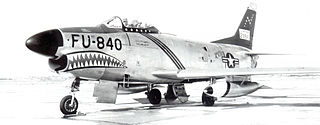
The 530th Air Defense Group is a disbanded United States Air Force organization. Its last assignment was with the 9th Air Division at Geiger Field, Washington, where it was inactivated on 18 August 1955. The group was originally activated as the 530th Air Service Group, a support unit for the 301st Bombardment Group at the end of World War II in Italy and then redeployed to the United States where it continued to support the 301st until it was inactivated in 1945.

The 4700th Air Defense Group is a discontinued United States Air Force (USAF) organization. Its last assignment was with the 4709th Air Defense Wing at Stewart Air Force Base, New York. It was activated in 1950 as a support unit for USAF units at Stewart. In 1954, it assumed an operational mission and was assigned two interceptor squadrons. The group was discontinued on 18 August 1955 and its personnel and equipment were transferred to the 329th Fighter Group as part of Project Arrow, an Air Defense Command project to air defense groups with fighter units with distinguished histories from World War I or World War II.

The 4730th Air Defense Group is a discontinued United States Air Force organization. Its last assignment was with the New York Air Defense Sector at McGuire Air Force Base, New Jersey, where it was discontinued in 1959.

The 4722d Air Defense Group is a discontinued United States Air Force organization. Its last assignment was with the 27th Air Division at George Air Force Base, California, where it was discontinued in 1958.

The 502d Air Defense Group is a disbanded United States Air Force organization. Its last assignment was with Air Defense Command (ADC)'s 4708th Air Defense Wing, at Youngstown Municipal Airport, Ohio. It was inactivated on 18 August 1955.

The 575th Air Defense Group is a disbanded United States Air Force organization. Its last assignment was with the 4708th Air Defense Wing at Selfridge Air Force Base, Michigan, where it was inactivated in August 1955. The group was originally activated as the 575th Air Service Group, a support unit for the 4th Fighter Group after the 4th returned to the United States at the end of World War II and performed that mission until it was inactivated in 1947.
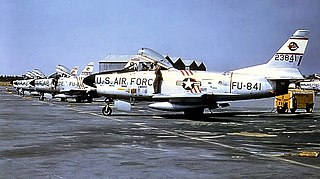
The 4729th Air Defense Group is a discontinued United States Air Force organization. Its last assignment was with the Boston Air Defense Sector at Westover Air Force Base, Massachusetts, where it was discontinued in 1958.

The 566th Air Defense Group is a disbanded unit of the United States Air Force. Its last assignment was with the 28th Air Division at Hamilton Air Force Base, California, where it was inactivated on 18 August 1955. The group was originally activated as the 566th Air Service Group, a support unit for a combat group at the end of World War II but never deployed before it was inactivated in 1945.
Vittorio Sanseverino was an Italian pilot. Besides his combat experience in World War II, he is known for having test-flown a large part of the aircraft built by FIAT for the postwar Italian Air Force, including the Fiat G.91, the Fiat G.222, the North American F-86D Sabre and the F-104 Starfighter.





























